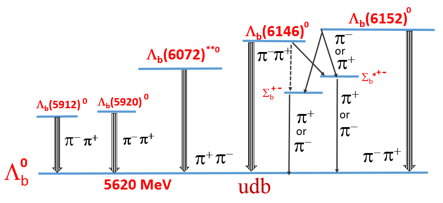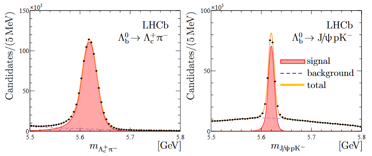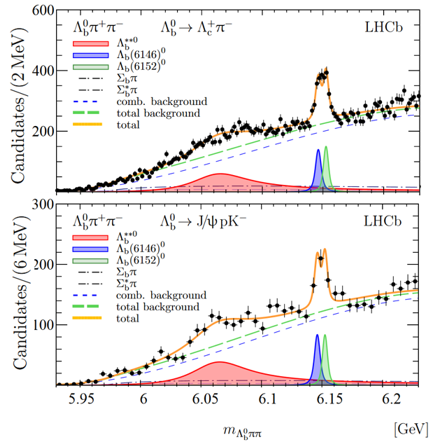Today at the Winter Meeting on Nuclear Physics, Bormio, Italy, the LHCb collaboration announced the discovery of a new beauty baryon particle. The new particle is observed in the Λb0π+π– spectrum using the full LHCb Run 1 and Run 2 data set, corresponding to an integrated luminosity of 9fb-1.
The lightest baryon, the proton, which is the nucleus of the hydrogen atom, is composed of three light quarks uud while its neutral partner the neutron is composed of udd quarks. If one of the d quarks is replaced by a heavier strange quark s, we obtain a Λ0 particle composed of uds quarks. Furthermore, if the s quark in the Λ0 baryon is replaced by a charm quark c or a beauty quark, we obtain a Λc+ or a Λb0 baryon particle. The three quarks udb forming the Λb0 are in their lowest-energy quantum mechanical state: the ground state. Like electrons in atoms, the quarks can be rearranged into excited states with different values of angular momentum and quark spin orientation. LHCb has already announced the observation of the two excited states of Λb0 baryon, known as the Λb(5912)0 and Λb(5920)0, in 2012; another discovery followed more recently, with the existence of two additional excited states, Λb(6146)0 and Λb(6152)0, being announced six months ago. All these particles were discovered in the Λb0π+π– invariant mass spectrum. The first two states are interpreted as the first orbital excitations of the Λb0 baryon, while the other two are compatible with predictions for the 1D excited states. The particle announced today, Λb**0, adds another brush stroke to the painting and is interpreted as the first radial excitation, the 2S state.
The first stage of the analysis is to reconstruct the Λb0 ground state. These baryons are formed in two different ways: from Λc+π– and J/ψpK– combinations, with J/ψ→μ+μ– and Λc+→pK–π+. The images at the left show the invariant mass spectra of the large, low-background samples of reconstructed Λb0 baryons. The images below show the Λb0π+π– invariant mass spectrum, with data points obtained using the two independent Λb0 decay modes.
The two narrow peaks in blue and green represent the two excited states Λb(6146)0 and Λb(6152)0 discovered by LHCb six months ago. The broad red distribution shows the contribution from the Λb**0 particle whose discovery was announced today. The broad Λb**0 peak has an overwhelming statistical significance for each Λb0 decay mode individually, well above the threshold necessary to claim a discovery. The broad width indicates that the 2S excited state has a shorter lifetime than the narrow 1D states, according to the fundamental rules of quantum mechanics. The mass of the new Λb**0 baryon is measured to be 6072.3±2.9±0.6±0.2 MeV, and its width Γ is 72±11±2 MeV.
Earlier this year, the LHCb collaboration reported a new system of particles interpreted as four narrow excited states of Ωb– baryon (with two above the observation threshold). In 2018 two excited states of Σb baryons were observed by LHCb. With these and other LHCb observations the total number of known beauty baryons has more than doubled. LHCb physicists have also discovered new charmed baryons such as five excited states of the Ωc0 in 2017.
In the 19th century, physicists observed that different elements emitted light in narrow coloured spectral lines. At the beginning of 20th century, quantum mechanics explained these spectral lines as manifestation of transitions from excited states of atoms. In the 1950s, physicists studied excited states of atomic nuclei where transitions from excited states were observed as emission of energetic gamma rays or other particles. Today, LHCb physicists continue work of their predecessors by studying excited states of quark systems and discovering the rich spectrum of Λb0 and Σb0 resonances. Here the transitions are not observed as electromagnetic radiation, but as emission of pions (π) or pion pairs (π+π–).
Read more in the LHCb conference presentation and in the LHCb paper. In addition, a CMS paper appeared on the arXiv today, confirming the previously reported LHCb observations of four narrow excited states of the Λb0 baryon in the Λb0π+π– invariant mass spectrum. CMS also reported evidence for a broad excess of events in the region 6040–6100 MeV, with mass and width consistent with those of the Λb**0 just observed by LHCb.



